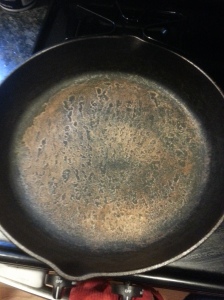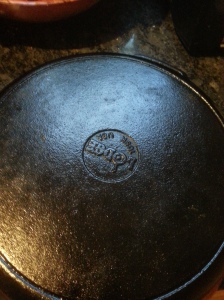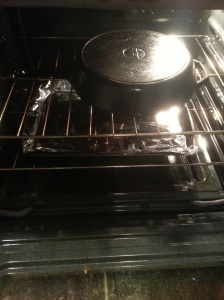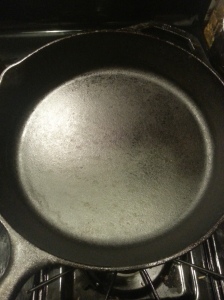Recent events have caused my beloved cast iron pan to fall into a state of ruin. Apparently one of my roommates had committed the grave error of not re-surfacing the seasoning after he scrubbed it off with salt and vinegar and boiling water. The seasoning on a cast iron pan is very important, as it protects the iron and makes a non-stick cooking surface. Here, check out the damage:
Yeesh, doesn’t look too hot. But don’t despair, this mess can be fixed by reseasoning the pan. Reseasoning cast iron is one of my favorite pastimes, mainly because every time you cook on it, you are reseasoning it (Reason #17 why cast iron rules.) Once you have a good base layer on, pretty much any oily food will add to the seasoning. Unfortunately, your lovely seasoning layer can be ruined for a number of reasons, like abrasive cooking tools, acidic foods like tomatoes, or well-meaning roommates who let a cast iron pan soak.
When I first got my pan, I looked up the best way to give it its first layer of seasoning. I found about thirty different blogs all claiming the best way to do it, including one that used long and fancy words like “electrolysis” and “lye”. Seriously, electrolysis to strip off rust and old seasoning? People have been cooking with cast iron for centuries, don’t overthink it. What all these blogs had in common is that you really only need two things to season a pan – oil and heat.
The basic science behind seasoning a pan is that combusting an oil causes release of free radicals. Think of free radicals as compulsive kleptomaniacs. They’re missing an electron, making them unstable, and they won’t feel complete until they steal one. So, they break in next door and steal an electron from neighboring oxygen molecules, damaging their integrity of and turning them into free radicals, causing a chain reaction. (Wait, kleptomania isn’t contagious. End of analogy.) This oxidization is how free radicals damage cells and cause aging. Reactive oxygen molecules are like your neighbors who leave the door unlocked with all their electrons in plain sight. Those antioxidants that I keep hearing so much about these days are molecules with electrons to spare without becoming destabilized themselves. Free radicals will pick up the antioxidant’s electrons and become stable without damaging other molecules, like leaving a bowl with free stuff outside to placate your kleptomaniac neighbors. (OK, end of analogy for real.)
In addition to messing up your body, the formation of free radicals in oil causes chain reaction polymerization, where the oil’s molecules cross-link and harden, forming a nice smooth surface across the pan’s bottom.
Wouldn’t the free radicals be bad for you?
Only if you’re eating the pan. By the time the pan comes out, all the free radicals will have been turned into polymers. The most free radicals are formed at an oil’s smoke point. Isn’t it funny? Free radicals, which we normally abhor, transform into smooth, non-stick cooking surfaces! Thanks, free radicals!
So how do I season/reseason a cast iron pan?
Start by preheating the oven to as hot as it can go. 400-500 degrees is fine. Since it’s so hot in here, make yourself a drink to cool off. I chose the essential cooler, a cranberry and vodka (Cape Codder for you fancy folks) served in a beach glass.
If you’re seasoning a pan from jump, you’ll need to scrub off the protective layer that came with the pan from the factory. This is probably the first and last time you’ll use soap on it. For reseasoning, just make sure any crap stuck on the pan is cleaned off. Use some hot water, a stiff nylon brush or steel wool. Afterwards, stick the pan on a burner on medium-low heat for about 10 minutes to dry the pan, inside and out. Any water residue in the pan will prevent even coating because the oil, being non-polar, won’t flow into water spots. If you have rust, you can scrape it off with kosher salt and steel wool. Serious damage can be burned off by throwing it a fire (though I don’t speak from experience.)
Once the pan has cooled, grab some olive oil and rub it into the pan. Olive oil is good because everyone has it, and it has a low smoke point.
Why You’re Wrong About…Olive Oil
Some people say don’t use olive oil for sauteing because of its low smoke point. Some people are also wrong. Here’s why:
1. Olive oil makes vegetables taste great.
2. It’s low in saturated fats, high in monounsaturated fats.
3. Most gas burners only get to around 350-400 degrees at medium-high heat, just below the smoke point of EVOO*.
4. If you’re sauteing in a pan full of heavily smoking olive oil, you did something wrong, and it wasn’t the choice of oil.
*I apologize for using a Rachael Ray acronym. It’s the last time, I promise.
Anyway, make sure to cover all sides of the pan. Don’t forget the back too!
Don’t be shy with the oil, but make sure to buff it in with paper towels. The pan should have a thin layer all over, but not overly sticky and no goopy spots. Once you’ve done that, wash your hands and cover a cookie sheet with aluminum foil. You’ll thank me later, trust me. By now, your oven should be preheated (I chose 450 degrees this time.) The pan looks much better now, but we need to form our free radicals! Also, unplug your smoke alarm and open a window. It’s gonna get Cheech and Chong up in this piece.
Stick the pan and the cookie sheet in the oven and set the timer for an hour and a half. This gives you enough time to watch David Lynch’s 1977 classic Eraserhead, with a minute to reflect on what you just saw. I chose to mop the kitchen floor instead.
After an hour, (what did I say? The timing doesn’t have to be exactly that, but the longer the better and the pan should bake for at least half an hour) turn off the oven but keep the door closed. Leave the pan there for about two more hours while you fix yourself another drink. This is important. (Not the drink part, the waiting part.) Iron is a poor conductor but has a lot of thermal energy. This means that it heats up and cools down slowly. I turned my oven off at 9 and grabbed it at 11, and it was still warm to the touch. Don’t be a fool.
Once the pan is cool and your hangover is kicking in, take it out and admire your handiwork.
Voila! Looks nice, doesn’t it? If there’s thick spots or the pan is sticky, go ahead and repeat the process. This time, use more oil/higher heat. The seasoning on the pan will form in layers, so it’s better to go in for two rounds with less oil than one round with more. If your pan was rusty and you scrubbed it down to the gray iron layer, you’ll want to put more than one layer on it.
This looks like a lot of work. Do I really have to do this?
Depends. If you inherited your cast iron pan, chances are it has a good layer of seasoning on it already. In this case, regular cooking of oily foods will add to the layers of seasoning. Lucky you!
For people with new pans, most come pre-seasoned. The one I own was pre-seasoned, but I decided to season it anyway. If you don’t want to go through the rigmarole, cooking a pack of bacon in your new pan and rubbing the fat into the still-warm pan will do wonders. If you don’t want to cook a pack of bacon in your pan, get out.
OK, I did it. And it looks great. How do I wash my pan without ruining the seasoning?
You don’t! After you cook something in it, throw out the leftover food bits and oil. Buff the greasy bottom with a paper towel until smooth. (Just like my weekend.) Cast iron doesn’t need to be washed unless there’s oil and food bits spattered all over.
There’s oil and food bits spattered all over.
You’ll need to clean it, then. Cast iron has an unorthodox but simple cleaning process. First, unlearn everything you’ve learned about cleaning pans. Cast iron should be cleaned promptly after cooking, while the pan is still warm but not hot. Run the pan under hot water, no soap. Use a nylon brush and kosher salt to clean off stuck food. Really stuck food can be scraped off with a bit of steel wool. Really, really stuck food can be removed by boiling a little water in the pan, then rinsing off the bits that come loose. Make sure to dry it well, as water + iron = rust. And then you’d have to start all over.
The two main directives of cleaning cast iron are don’t put it in the dishwasher and don’t put soap on it. (OK, you can use mild dish soap on it if you’re really paranoid. But cast iron heats to 400-500 degrees during cooking, pathogens die at 212. You do the math.) If you do use soap, don’t soak the pan. Use it as needed to get tough spots. If you season right, you”ll never have tough spots.
So, do I have to do this every time?
No, the pictured steps are for restoring a base layer of seasoning, in case yours was destroyed by some chump. You can protect your pan by promptly cleaning it after each use, then rubbing a thin layer of oil in with a paper towel and gently heating it on low for about 5 minutes. Remember, oil = good! It keeps water off the iron so rust can’t form. Over time, you’ll get a cool jet black patina on the bottom that will keep your iron tough and foods from sticking. This is one pan that’s okay to put away greasy.
What’s this about not cooking tomatoes in the pan?
You should be careful about cooking tomatoes because they’re acidic. Here’s an experiment you can try at home. Put some ketchup on a plate and cover it with foil, making sure the foil is touching the ketchup, then stick it in the fridge. Tomorrow morning, you’ll have a fun surprise! Acid is pretty cool that way. It’s not the end of the world if you do make meat sauce or something like that in your pan, especially as you build a powerful seasoning layer. But early in your pan’s career, use discretion.
Cast iron pans are very versatile, from sauteing vegetables to pan pizzas in the oven. You can even use it on your outdoor grill, or directly on a fire! Treat your cast iron well, and it will outlast you. Seriously, this pan will be at your funeral.
(GIF credits: http://www.luvimages.com/image/radical_gif-3839.html, http://upload.wikimedia.org/wikipedia/commons/9/90/Animated_clock.gif)







